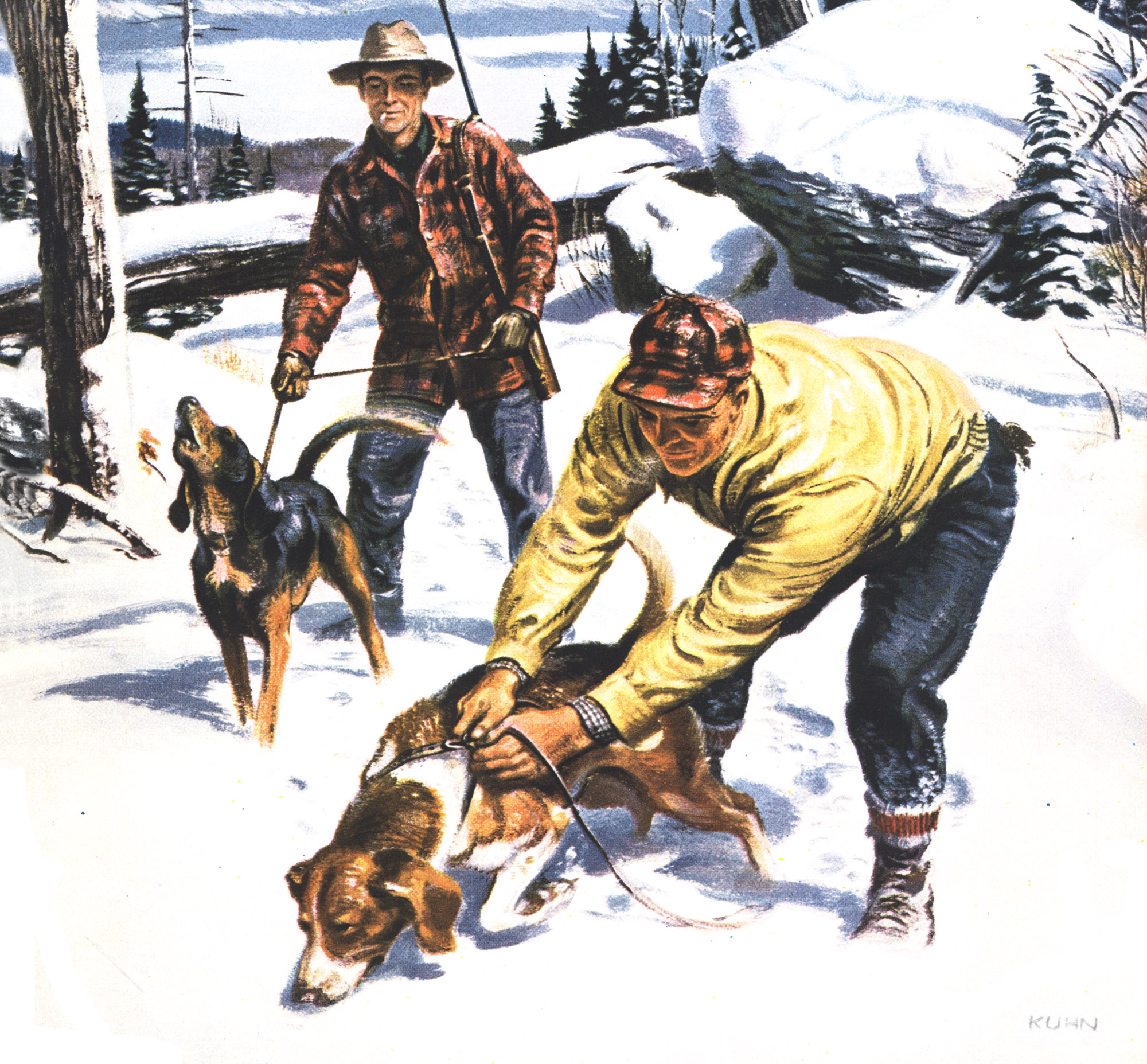How Your Clothes Could Save Your Life in the Next Crisis
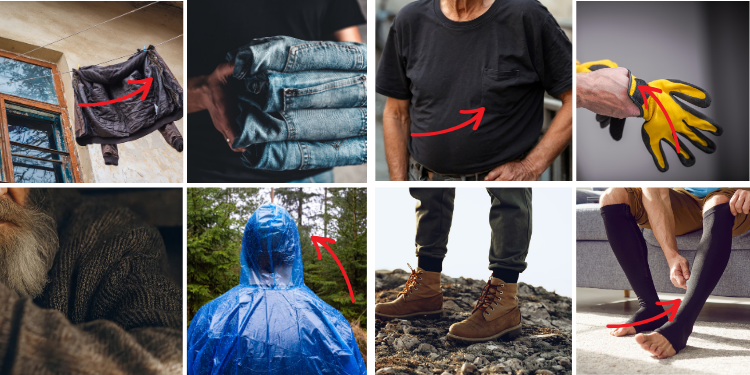
In an uncertain world, shaped by natural disasters, power grid failures, and civil unrest, you might be left with nothing more than the clothes on your back! While shelf-stable food, water purification, and shelter often take the spotlight, in most preparedness strategies, one often-overlooked asset in an emergency is the clothing you already own.
Beyond their basic function, you might be surprised at all the different ways everyday clothes can be adapted for dozens of life-saving purposes. With a little knowledge, the clothes in your closet can be considered a high-value resource in your prepping strategy.
T-Shirts
The humble t-shirt is far more than a casual layer. Cotton t-shirts can be layered to be used as makeshift water filters. They can also be used as improvised tourniquets, shredded into fire-starting tinder, and even signal flags if brightly colored. In a pinch, I’ve even torn the sleeve off a T-shirt to use as toilet paper!
Jeans
Most modern-day jeans are made from heavy-duty denim, which makes them ideal for creating durable cordage. Just bear in mind that jeans with a small percentage of spandex in the fibers will stretch over time.
You can also remove the back pockets from jeans or cut the fabric into sections that can be duct taped or bound together to create knee pads or shin guards. In a desperate pinch, you can even use layers of jeans to create even makeshift sandals and shoes.
Jackets & Hoodies
In normal times, hooded jackets offer warmth and weather protection. In disaster, they can also serve as bags, containers, or even be modified into a makeshift bucket.
You can use the hood to carry food or kindling or even fill the sleeves with dry leaves for insulation. Waterproof or windproof jackets can double as makeshift bivy sacks in wet conditions.
I even had once when I needed to transport water from a creek to make sure my campfire was 100% extinguished. So, I lined a hood with plastic and used it to scoop water and carry it like a bucket back to camp.
Speaking of water, securing this critical resource is non-negotiable for survival. I found a slick, game-changing solution that uses everyday gear—a barrel, hose, and a few basic tools—to pull up to 40 gallons of water a day, practically out of thin air. This ingenious DIY water generator is a must-have for any prepper’s kit.

Wool Sweaters
Wool is a miracle fabric for survival. It retains heat even when wet and is naturally fire-resistant. With a little patience, you can unravel parts of a wool sweater to use the fibers as lightweight cordage or string. I once used strands from a sweater to help tie the grommets of a tarp in place on a windy day.
Socks
 Extra socks are crucial for protecting your feet, which helps when you’re on the move, but also have multipurpose uses. Stuffed with rice or beans and left safely near a fire they become heating pads. Filled with charcoal or sand, they can be used to make water filters.
Extra socks are crucial for protecting your feet, which helps when you’re on the move, but also have multipurpose uses. Stuffed with rice or beans and left safely near a fire they become heating pads. Filled with charcoal or sand, they can be used to make water filters.
In extremely hot conditions, you can soak a pair of socks in cold water. Then tie them around your neck. This will help keep you cool and help your body regulate brain temperature, as well as other heat-related nerve responses.
Bandanas
Bandanas are some of the most versatile clothing accessories to have with you in a crisis. You can quickly improvise one as a dust mask, a sling, a water filter, a bandage, or even a fire starter. Folded properly, they’re easy to store in a pocket and ready at a moment’s notice.
Belts
A sturdy belt can serve as a tourniquet, a strap for carrying firewood or a way to secure splints. Leather belts can also be used to strop knives in the field, keeping your blades sharp and functional.
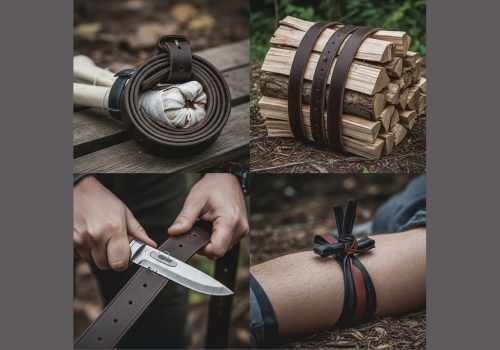
A belt can also be used for self-defense. Martial arts like Krav Maga, Kali, Jiu-Jitsu, and Korean Hapkido all have techniques where a belt can be used for self-defense.
I’ve picked up a ton of self-defense skills, including how to looter-proof my property, from Joel Lambert’s A Navy SEAL’s Bug-In Guide. It’s packed with hardcore tactics from a battle-tested SEAL to lock down your homestead and keep threats at bay when SHTF.
Scarves & Headcovers
A scarf is essentially a large piece of fabric with many uses. As is, they’re an easy form of sun protection. Depending on the type of fabric it’s made from, a scarf can be used as a water filter, bandages, improvised bags, and even a baby carrier.
A brightly colored scarf can also be used for orienteering and signaling for help. Small strips can be cut and tied to tree branches to mark a path or signal to a search plane.
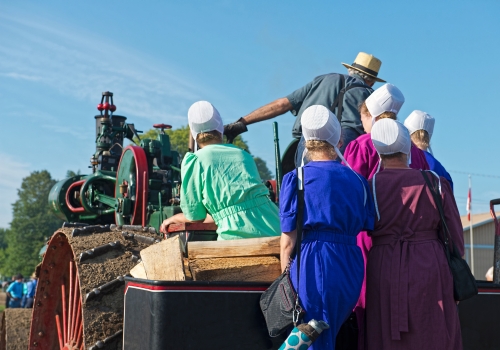
The Amish have mastered the art of keeping it simple and versatile, turning everyday items like scarves and headcovers into real survival tools. Passed down through generations, they’re built to last. Got a cold? Soak a scarf in herbal remedies and wear it for relief.
On the move? Use it as a pouch or padding for gear. This is battle-tested self-reliance from a community that’s been off-grid since the 1800s. Want more gritty, practical know-how? The Amish Ways Book spills the secrets of how one of America’s toughest off-grid groups has survived and thrived for centuries.
Gloves
Beyond keeping your hands warm, gloves protect against abrasions, burns, and blisters. They’re essential for tasks like handling firewood, digging, or working with tools.
I keep an insulated, leather welding glove in my to-go bag and the tactical backpack I use for camping. This gives me the ability to touch hot logs, handle cast iron pans cooking over the fire pit or grab anything else that’s hot.
You can also set up a dedicated space to stash all your survival essentials. Think underground bunker, like The Easy Cellar, which you can build right in your backyard—fast, simple, and even if you’ve got zero experience. It’s dirt-cheap, so there’s no excuse not to lock one down. Inside, you can safely store tools and gear critical for post-SHTF scenarios.
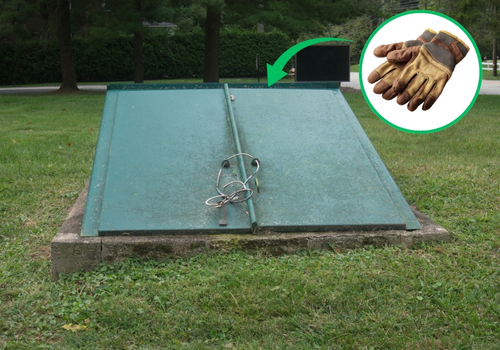
But some of that equipment can be risky if mishandled, so don’t skimp on safety. I strongly recommend tossing a pair of high-quality gloves in your bunker to keep your hands protected while working with heavy-duty tools. Stay sharp, stay safe, and keep your preps secure!
Underwear
Clean underwear can be repurposed into slings, water filters, and emergency bandages. Underwear made from synthetic materials tends to dry quickly and can even be fashioned into makeshift water-resistant bags when knotted properly.
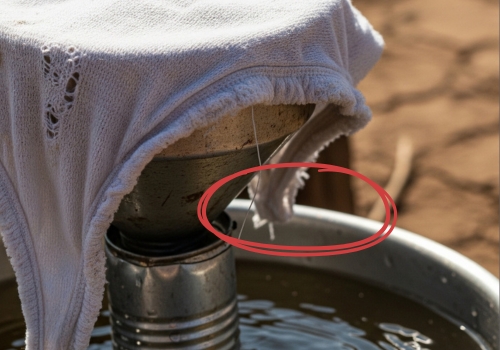
NOTE: We’re talking about clean, unworn undergarments. Don’t even think about using used underwear for anything that requires sanitary conditions, as there’s a real risk of bacterial transfer from body soil.
Sports Bras or Compression Garments
In normal times, sports bras and compression garments provide physical support. Yet the heavy-duty Lycra Spandex they’re made from can also be used for things like improvised bandages or gear holsters.
On a recent wilderness retreat, one of my friends suffered a nasty burn on his leg, on our last night in the bush. We needed to keep it covered for the hike out. Unfortunately, he was sweaty, it was wet conditions, and adhesive bandages alone wouldn’t stay put.
The best option that worked was to tie the bandage to his leg with his wife’s bright pink sports bra. It flexed enough to move with him as he walked, without slipping so much that the bandage underneath exposed the burn.
Rain Poncho & PVC Clothing
These are excellent for creating makeshift shelters, collecting rainwater, or wrapping around gear to keep it dry. Cut and tied properly, a poncho can also serve as a groundsheet or emergency blanket.
In a pinch, I’ve even sliced up an old pair of PVC rain bibs to make a small rainfly over our tent. However, it helps if the PVC sheeting is also reinforced with a thin layer of fabric. This prevents catastrophic rips under tension.
When SHTF and you’re bugging out or stuck deep in the backcountry, makeshift shelters and rainwater rigs are just the starting point for staying alive. Whether you’re evading threats, living off-grid, or lost in the wild, you need hardcore skills to survive. We’re talking:
- Sourcing and purifying water in any terrain, no gear required
- Throwing up rugged shelters in under an hour with what’s around you
- Crafting natural meds for cuts, infections, or worse
- Staying warm without a fire or sleeping bag when temps drop
- Defending yourself against predators—four-legged or otherwise
The Wilderness Survival Guide by Nicole Apelian, a battle-tested survivalist and Alone vet, is your go-to manual. Packed with gritty, field-proven tactics, this isn’t your average prepper fluff—it’s the real deal for thriving when civilization’s gone.

Alternatively, or even as a bonus, you can level up your skills with hands-on training from Nicole. Join the Wilderness Survival Academy and unlock hard-earned secrets that could save your skin when SHTF. Learn gritty tips and tricks to thrive in the backcountry—faster than you might think you’ll need them.
👉 Check it out here!
Final Thoughts
In a crisis, your clothing is about more than just style or comfort. Many modern fabrics can be repurposed for filtering water, building shelter, treating wounds, improvising as tools, and fashioning protective padding.
Learning how to repurpose them for survival isn’t just smart, it could save your life. So next time you look at your wardrobe, consider not just what it says about your fashion sense, but what it might do with them if all else fails.
Want to take your self-reliance to the next level? The Forager’s Guide to Wild Foods teaches you how to safely identify and use over 400 edible plants growing all around you. In a crisis, nature becomes your pantry—if you know where to look. Check it out here.
You may also like:

#1 Silent Killer Hiding in Your Garage
The “Doomsday Ration” That Can Keep an Adult Well Fed For Just $0.37/day (Video)
28 Underrated Prepping Items That Could Save Your Life
THIS Will Get You Killed In The Wild
Read the full article here









